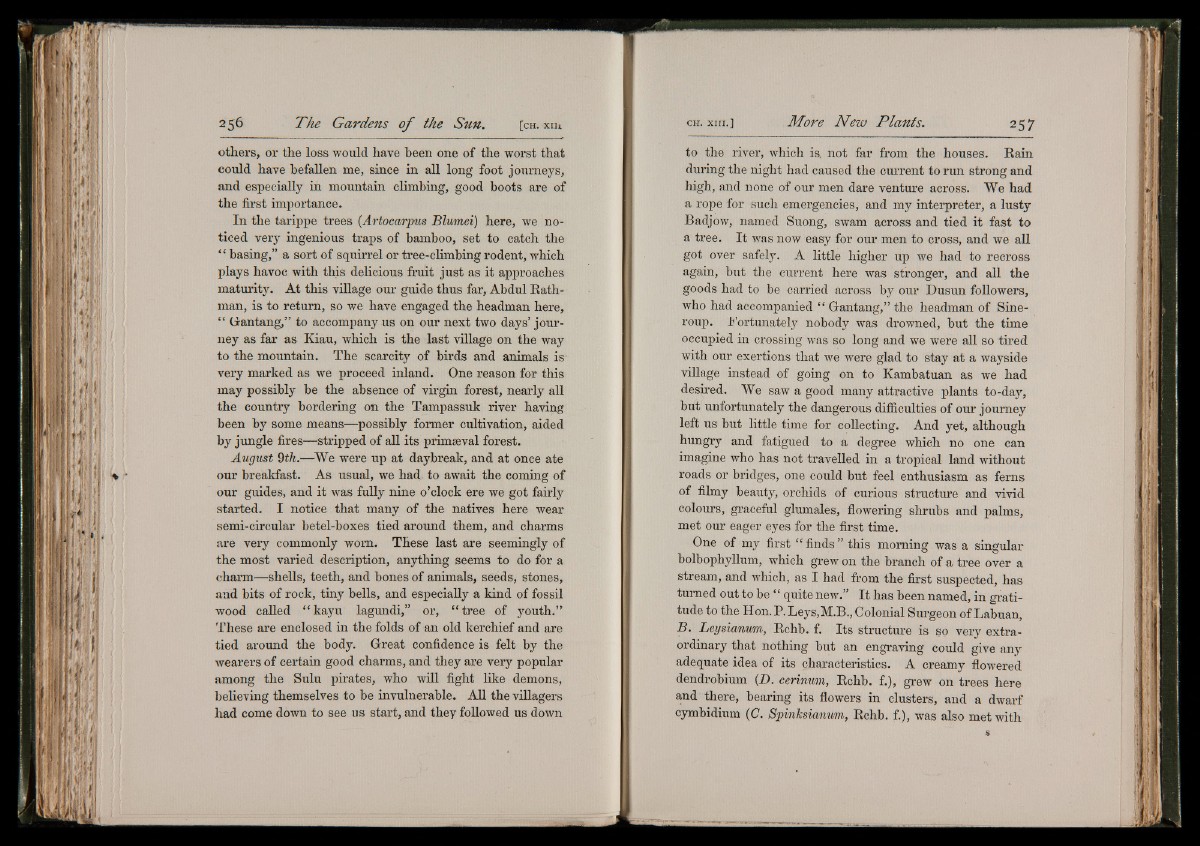
others, or the loss would have been one of the worst that
could have befallen me, since in all long foot journeys,
and especially in mountain climbing, good boots are of
the first importance.
In the tarippe trees (Artocarpus Blumei) here, we noticed
very ingenious traps of bamboo, set to catch the
“ basing,” a sort of squirrel or tree-climbing rodent, which
plays havoc with this delicious fruit just as it approaches
maturity. At this village our guide thus far, Abdul Rath-
man, is to return, so we have engaged the headman here,
“ Gantang,” to accompany us on our next two days’ journey
as far as Kiau, which is the last village on the way
to the mountain. The scarcity of birds and animals is
very marked as we proceed inland. One reason for this
may possibly be the absence of virgin forest, nearly all
the country bordering on the Tampassuk river having
been by some means—possibly former cultivation, aided
by jungle fires—stripped of all its primaeval forest.
August 9th.—We were up at daybreak, and at once ate
our breakfast. As usual, we had to await the coming of
our guides, and it was fully nine o’clock ere we got fairly
started. I notice that many of the natives here wear
semi-circular betel-boxes tied around them, and charms
are very commonly worn. These last are seemingly of
the most varied description, anything seems to do for a
charm—shells, teeth, and bones of animals, seeds, stones,
and bits of rock, tiny bells, and especially a kind of fossil
wood called “ kayu lagundi,” or, “ tree of youth.”
These are enclosed in the folds of an old kerchief and are
tied around the body. Great confidence is felt by the
wearers of certain good charms, and they are very popular
among the Sulu pirates, who will fight like demons,
believing themselves to be invulnerable. All the villagers
had come down to see us start, and they followed us down
to the river, which is. not far from the houses. Rain
during the night had caused the current to run strong and
high, and none of our men dare venture across. We had
a rope for such emergencies, and my interpreter, a lusty
Badjow, named Suong, swam across and tied it fast to
a tree. It was now easy for our men to cross, and we all
got over safely. A little higher up we had to recross
again, but the current here was stronger, and all the
goods had to be carried across by our Dusun followers,
who had accompanied “ Gantang,” the headman of Sine-
roup. Fortunately nobody was drowned, but the time
occupied in crossing was so long and we were all so tired
with our exertions that we were glad to stay at a wayside
village instead of going on to Kambatuan as we had
desired. We saw a good many attractive plants to-day,
but unfortunately the dangerous difficulties of our journey
left us but little time for collecting. And yet, although
hungry and fatigued to a degree which no one can
imagine who has not travelled in a tropical land without
roads or bridges, one could but feel enthusiasm as ferns
of filmy beauty, orchids of curious structure and vivid
colours, graceful glumales, flowering shrubs and palms,
met our eager eyes for the first time.
One of my first “ finds” this morning was a singular
bolbophyllum, which grew on the branch of a tree over a
stream, and which, as I had from the first suspected, has
turned out to be “ quite new.” It has been named, in gratitude
to the Hon. P. Leys,M.B., Colonial Surgeon of Labuan,
B. Leysianum, Rchb. f. Its structure is so very extraordinary
that nothing but an engraving could give any
adequate idea of its characteristics. A creamy flowered
dendrobium (D . cerinum, Rchb. f.), grew on trees here
and there, bearing its flowers in clusters, and a dwarf
cymbidium (C. Spinksianum, Rchb. f.), was also met with